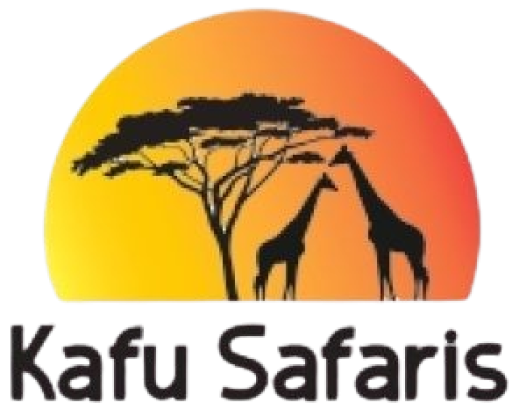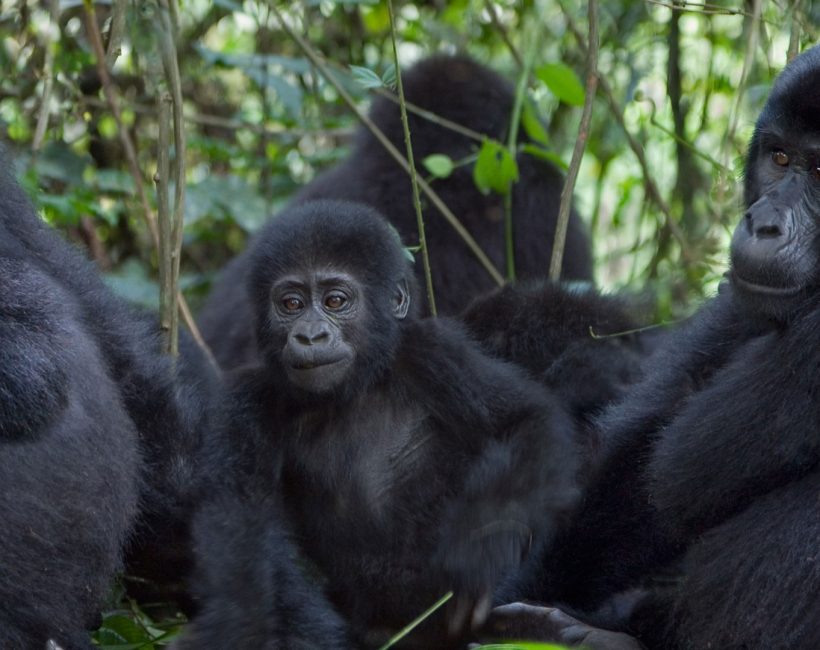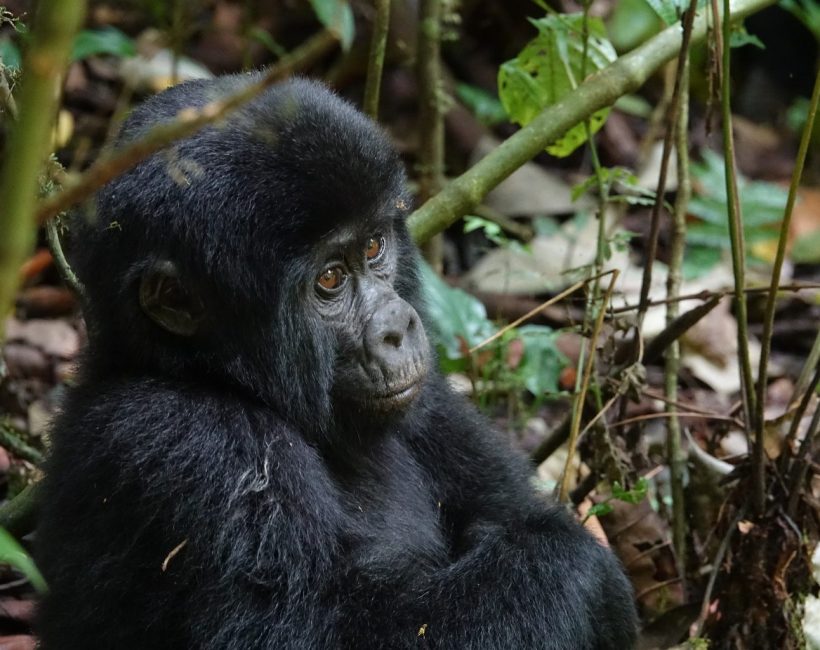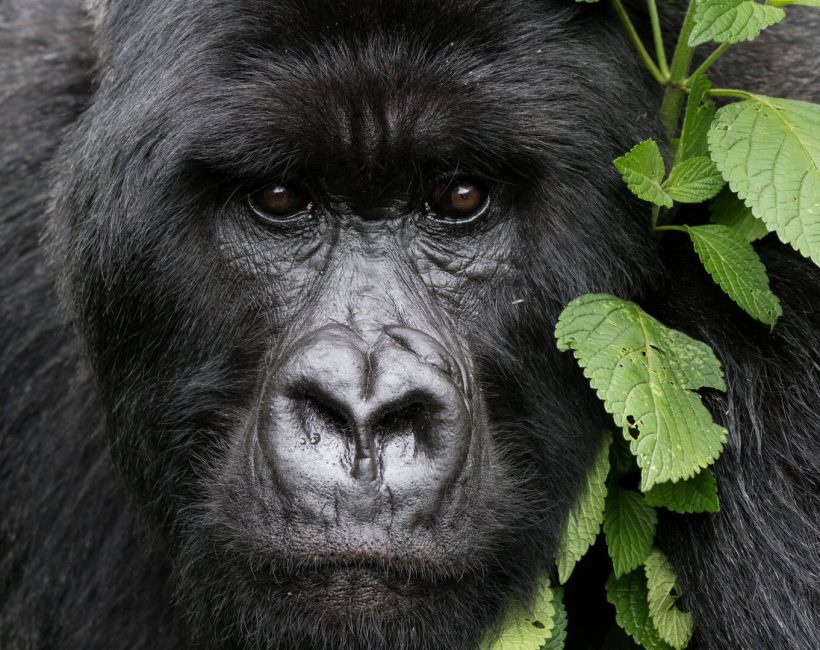Gorilla Trekking
- Home
- Gorilla Trekking
Man's Closest Relatives
Gorilla trekking in Uganda offers a once-in-a-lifetime opportunity to experience one of the world’s most magnificent creatures in its natural habitat. Nestled in the heart of Africa, Uganda is home to more than half of the world’s remaining mountain gorillas, making it a premier destination for this unique wildlife adventure. This article provides a comprehensive guide to gorilla trekking in Uganda, detailing the experience, destinations, packing tips, and the essential rules and regulations to ensure a safe and respectful encounter with these gentle giants.
Popular Gorilla Trekking Tours
Frequently Asked Questions
Is Gorilla Trekking Safe?
Yes! Gorilla trekking is safe. You are accompanied by 2 armed rangers and guides. When you are with the gorillas, just follow your ranger’s instructions
Is Gorilla Trekking Worth the money
The encounters with these great apes is worth every penny. The trek is one of the most authentic wildlife encounters one can experience. Alot is spent in conservation and protection of these endangered species.
How Hard is gorilla trekking?
You need to be in a fairly good physical condition to enjoy the hike through the forest. The terrain is rugged and hilly. Take some walks weeks before your safari
What are the chances of seeing the gorillas?
You have a 95% chance of seeing the gorillas. Trackers are sent ahead of you to locate the gorillas and you will be directed through the forest. Otherwise, you would spend the entire day in the forest.
How long is the Gorilla trek?
The duration of the trek is dependent on the location of the gorilla family allocated to you. The trek lasts between 3-6 hours.
The Gorilla Trekking Experience
The best time to visit Rwanda is during the dry seasons, which are from June to September and from December to February. During these months, the weather is generally mild and pleasant, with lower chances of rainfall, making it ideal for gorilla trekking, wildlife viewing, and outdoor activities in national parks.
However, Rwanda’s climate is relatively stable throughout the year, so you can also consider visiting during the long rainy season from March to May or the short rainy season from October to November. Just be prepared for heavier rainfall during these periods, which may affect road conditions and outdoor activities.
Ultimately, the best time to visit Rwanda depends on your preferences and interests. Whether you choose to explore the lush landscapes during the rainy season or enjoy clear skies and cooler temperatures during the dry season, Rwanda offers a unique and enriching experience year-round.
The best time to visit Rwanda is during the dry seasons, which are from June to September and from December to February. During these months, the weather is generally mild and pleasant, with lower chances of rainfall, making it ideal for gorilla trekking, wildlife viewing, and outdoor activities in national parks.
However, Rwanda’s climate is relatively stable throughout the year, so you can also consider visiting during the long rainy season from March to May or the short rainy season from October to November. Just be prepared for heavier rainfall during these periods, which may affect road conditions and outdoor activities.
Ultimately, the best time to visit Rwanda depends on your preferences and interests. Whether you choose to explore the lush landscapes during the rainy season or enjoy clear skies and cooler temperatures during the dry season, Rwanda offers a unique and enriching experience year-round.
The Gorilla Trekking Experience
Bwindi Impenetrable National Park
Bwindi Impenetrable National Park, a UNESCO World Heritage site, is renowned for its remarkable biodiversity and dense, mist-covered forests. Located in southwestern Uganda, it is home to nearly half of the world’s mountain gorilla population. The park is divided into four trekking sectors:
- Buhoma: The Buhoma sector is the most accessible and popular, known for its well-established trails and numerous accommodation options. It offers a range of trekking experiences, catering to different fitness levels.
- Ruhija: This sector is less frequented, providing a more remote and intimate trekking experience. The trails here are more challenging, rewarding trekkers with breathtaking views and rich flora and fauna.
- Rushaga: Rushaga offers multiple gorilla groups and the opportunity for habituation experiences, where visitors can spend more time with the gorillas and witness the process of familiarizing them to human presence.
- Nkuringo: Known for its steep and demanding trails, the Nkuringo sector offers an adventurous trek and stunning panoramic views of the Virunga Volcanoes and the Albertine Rift Valley.
Mgahinga Gorilla National Park
Mgahinga Gorilla National Park, part of the larger Virunga Conservation Area, is Uganda’s smallest national park but equally rich in wildlife and natural beauty. The park lies at the confluence of Uganda, Rwanda, and the Democratic Republic of Congo. It is home to the Nyakagezi gorilla group, which is known for its transboundary nature, often moving between the three countries. The park is characterized by its volcanic mountains, lush bamboo forests, and diverse ecosystems. In addition to gorilla trekking, visitors can explore the Batwa Trail, experiencing the culture and history of the indigenous Batwa people, who were the original inhabitants of the forest.
The Gorilla Trekking Experience
The best time to visit Rwanda is during the dry seasons, which are from June to September and from December to February. During these months, the weather is generally mild and pleasant, with lower chances of rainfall, making it ideal for gorilla trekking, wildlife viewing, and outdoor activities in national parks.
However, Rwanda’s climate is relatively stable throughout the year, so you can also consider visiting during the long rainy season from March to May or the short rainy season from October to November. Just be prepared for heavier rainfall during these periods, which may affect road conditions and outdoor activities.
Ultimately, the best time to visit Rwanda depends on your preferences and interests. Whether you choose to explore the lush landscapes during the rainy season or enjoy clear skies and cooler temperatures during the dry season, Rwanda offers a unique and enriching experience year-round.
The best time to visit Rwanda is during the dry seasons, which are from June to September and from December to February. During these months, the weather is generally mild and pleasant, with lower chances of rainfall, making it ideal for gorilla trekking, wildlife viewing, and outdoor activities in national parks.
However, Rwanda’s climate is relatively stable throughout the year, so you can also consider visiting during the long rainy season from March to May or the short rainy season from October to November. Just be prepared for heavier rainfall during these periods, which may affect road conditions and outdoor activities.
Ultimately, the best time to visit Rwanda depends on your preferences and interests. Whether you choose to explore the lush landscapes during the rainy season or enjoy clear skies and cooler temperatures during the dry season, Rwanda offers a unique and enriching experience year-round.
The Gorilla Trekking Experience
Packing appropriately for a gorilla trekking safari is crucial to ensure comfort and safety during the trek. Here is a comprehensive packing list to help you prepare:
Clothing
- Long-sleeved Shirts and Pants: Protect your skin from thorny plants, insect bites, and the sun.
- Waterproof Jacket: The weather in the forest can be unpredictable, and rain showers are common.
- Hiking Boots: Sturdy, waterproof boots with good ankle support are essential for navigating the rugged terrain.
- Hat and Gloves: A wide-brimmed hat for sun protection and gloves to shield your hands from stinging nettles and rough vegetation.
- Gaiters: Protect your lower legs from mud, insects, and debris.
Gear and Accessories
- Backpack: A comfortable, waterproof backpack to carry your essentials.
- Water Bottle and Snacks: Stay hydrated and energized during the trek.
- Camera and Binoculars: Capture memories and observe wildlife from a distance.
- Walking Stick: A trekking pole or walking stick for stability on steep and slippery trails.
- First Aid Kit: Basic medical supplies for any minor injuries or ailments.
- Insect Repellent and Sunscreen: Protect your skin from insects and UV rays.
- Plastic Bags: To keep your belongings dry and to pack out any trash.
Personal Items
- Passport and Permits: Ensure you have all necessary documents and permits for the trek.
- Cash: For tips, souvenirs, and any additional expenses.
- Medications: Any personal medications you may need during the trek.
Rules and Regulations of Gorilla Trekking
To ensure the safety of both the gorillas and the trekkers, strict rules and regulations are enforced during gorilla trekking. These guidelines are designed to minimize human impact on the gorillas and their habitat and to provide a respectful and sustainable wildlife experience.
- No Trekking When Sick: If you are ill or have a contagious disease, you are not allowed to trek. Gorillas are susceptible to human illnesses, which can be fatal to them.
- Sanitization: Wash your hands before starting the trek to reduce the risk of transmitting diseases.
- Group Size: A maximum of eight visitors per gorilla group per day to reduce stress on the animals and minimize habitat disturbance.
- Distance: Maintain a minimum distance of 7 meters (about 23 feet) from the gorillas at all times.
- No Flash Photography: Flash can startle and distress the gorillas.
- Behavior: Speak in a low voice, avoid sudden movements, and do not make direct eye contact with the gorillas.
- Time Limit: The maximum time allowed with the gorillas is one hour to reduce their exposure to humans.
- No Eating or Drinking: Consumption of food and drink near the gorillas is prohibited to prevent contamination.
Gorilla trekking in Uganda is an unforgettable adventure that offers a unique and intimate glimpse into the world of mountain gorillas. From the dense forests of Bwindi to the volcanic landscapes of Mgahinga, Uganda provides the perfect backdrop for this extraordinary wildlife experience. By preparing adequately, following the guidelines, and respecting the natural environment, trekkers can enjoy a safe and fulfilling encounter with these magnificent creatures. Whether you are an avid wildlife enthusiast, a nature lover, or an adventure seeker, gorilla trekking in Uganda promises a journey filled with awe, wonder, and a profound connection to one of the planet’s most endangered and captivating species.
Mgahinga Gorilla National Park, part of the larger Virunga Conservation Area, is Uganda’s smallest national park but equally rich in wildlife and natural beauty. The park lies at the confluence of Uganda, Rwanda, and the Democratic Republic of Congo. It is home to the Nyakagezi gorilla group, which is known for its transboundary nature, often moving between the three countries. The park is characterized by its volcanic mountains, lush bamboo forests, and diverse ecosystems. In addition to gorilla trekking, visitors can explore the Batwa Trail, experiencing the culture and history of the indigenous Batwa people, who were the original inhabitants of the forest.
Gorilla Trekking
- Home
- Gorilla Trekking
Welcome to Rwanda
A Jewel of East Africa
Gorilla trekking in Uganda offers a once-in-a-lifetime opportunity to experience one of the world’s most magnificent creatures in its natural habitat. Nestled in the heart of Africa, Uganda is home to more than half of the world’s remaining mountain gorillas, making it a premier destination for this unique wildlife adventure. This article provides a comprehensive guide to gorilla trekking in Uganda, detailing the experience, destinations, packing tips, and the essential rules and regulations to ensure a safe and respectful encounter with these gentle giants.
Popular Gorilla Trekking Tours
Frequently Asked Questions
Is Gorilla Trekking Safe?
Yes! Gorilla trekking is safe. You are accompanied by 2 armed rangers and guides. When you are with the gorillas, just follow your ranger’s instructions
Is Gorilla Trekking Worth the money
The encounters with these great apes is worth every penny. The trek is one of the most authentic wildlife encounters one can experience. Alot is spent in conservation and protection of these endangered species.
How Hard is gorilla trekking?
You need to be in a fairly good physical condition to enjoy the hike through the forest. The terrain is rugged and hilly. Take some walks weeks before your safari
What are the chances of seeing the gorillas?
You have a 95% chance of seeing the gorillas. Trackers are sent ahead of you to locate the gorillas and you will be directed through the forest. Otherwise, you would spend the entire day in the forest.
How long is the Gorilla trek?
The duration of the trek is dependent on the location of the gorilla family allocated to you. The trek lasts between 3-6 hours.
The Gorilla Trekking Experience
The best time to visit Rwanda is during the dry seasons, which are from June to September and from December to February. During these months, the weather is generally mild and pleasant, with lower chances of rainfall, making it ideal for gorilla trekking, wildlife viewing, and outdoor activities in national parks.
However, Rwanda’s climate is relatively stable throughout the year, so you can also consider visiting during the long rainy season from March to May or the short rainy season from October to November. Just be prepared for heavier rainfall during these periods, which may affect road conditions and outdoor activities.
Ultimately, the best time to visit Rwanda depends on your preferences and interests. Whether you choose to explore the lush landscapes during the rainy season or enjoy clear skies and cooler temperatures during the dry season, Rwanda offers a unique and enriching experience year-round.
The best time to visit Rwanda is during the dry seasons, which are from June to September and from December to February. During these months, the weather is generally mild and pleasant, with lower chances of rainfall, making it ideal for gorilla trekking, wildlife viewing, and outdoor activities in national parks.
However, Rwanda’s climate is relatively stable throughout the year, so you can also consider visiting during the long rainy season from March to May or the short rainy season from October to November. Just be prepared for heavier rainfall during these periods, which may affect road conditions and outdoor activities.
Ultimately, the best time to visit Rwanda depends on your preferences and interests. Whether you choose to explore the lush landscapes during the rainy season or enjoy clear skies and cooler temperatures during the dry season, Rwanda offers a unique and enriching experience year-round.
The Gorilla Trekking Experience
Bwindi Impenetrable National Park
Bwindi Impenetrable National Park, a UNESCO World Heritage site, is renowned for its remarkable biodiversity and dense, mist-covered forests. Located in southwestern Uganda, it is home to nearly half of the world’s mountain gorilla population. The park is divided into four trekking sectors:
- Buhoma: The Buhoma sector is the most accessible and popular, known for its well-established trails and numerous accommodation options. It offers a range of trekking experiences, catering to different fitness levels.
- Ruhija: This sector is less frequented, providing a more remote and intimate trekking experience. The trails here are more challenging, rewarding trekkers with breathtaking views and rich flora and fauna.
- Rushaga: Rushaga offers multiple gorilla groups and the opportunity for habituation experiences, where visitors can spend more time with the gorillas and witness the process of familiarizing them to human presence.
- Nkuringo: Known for its steep and demanding trails, the Nkuringo sector offers an adventurous trek and stunning panoramic views of the Virunga Volcanoes and the Albertine Rift Valley.
Mgahinga Gorilla National Park
Mgahinga Gorilla National Park, part of the larger Virunga Conservation Area, is Uganda’s smallest national park but equally rich in wildlife and natural beauty. The park lies at the confluence of Uganda, Rwanda, and the Democratic Republic of Congo. It is home to the Nyakagezi gorilla group, which is known for its transboundary nature, often moving between the three countries. The park is characterized by its volcanic mountains, lush bamboo forests, and diverse ecosystems. In addition to gorilla trekking, visitors can explore the Batwa Trail, experiencing the culture and history of the indigenous Batwa people, who were the original inhabitants of the forest.
The Gorilla Trekking Experience
The best time to visit Rwanda is during the dry seasons, which are from June to September and from December to February. During these months, the weather is generally mild and pleasant, with lower chances of rainfall, making it ideal for gorilla trekking, wildlife viewing, and outdoor activities in national parks.
However, Rwanda’s climate is relatively stable throughout the year, so you can also consider visiting during the long rainy season from March to May or the short rainy season from October to November. Just be prepared for heavier rainfall during these periods, which may affect road conditions and outdoor activities.
Ultimately, the best time to visit Rwanda depends on your preferences and interests. Whether you choose to explore the lush landscapes during the rainy season or enjoy clear skies and cooler temperatures during the dry season, Rwanda offers a unique and enriching experience year-round.
The best time to visit Rwanda is during the dry seasons, which are from June to September and from December to February. During these months, the weather is generally mild and pleasant, with lower chances of rainfall, making it ideal for gorilla trekking, wildlife viewing, and outdoor activities in national parks.
However, Rwanda’s climate is relatively stable throughout the year, so you can also consider visiting during the long rainy season from March to May or the short rainy season from October to November. Just be prepared for heavier rainfall during these periods, which may affect road conditions and outdoor activities.
Ultimately, the best time to visit Rwanda depends on your preferences and interests. Whether you choose to explore the lush landscapes during the rainy season or enjoy clear skies and cooler temperatures during the dry season, Rwanda offers a unique and enriching experience year-round.
The Gorilla Trekking Experience
Packing appropriately for a gorilla trekking safari is crucial to ensure comfort and safety during the trek. Here is a comprehensive packing list to help you prepare:
Clothing
- Long-sleeved Shirts and Pants: Protect your skin from thorny plants, insect bites, and the sun.
- Waterproof Jacket: The weather in the forest can be unpredictable, and rain showers are common.
- Hiking Boots: Sturdy, waterproof boots with good ankle support are essential for navigating the rugged terrain.
- Hat and Gloves: A wide-brimmed hat for sun protection and gloves to shield your hands from stinging nettles and rough vegetation.
- Gaiters: Protect your lower legs from mud, insects, and debris.
Gear and Accessories
- Backpack: A comfortable, waterproof backpack to carry your essentials.
- Water Bottle and Snacks: Stay hydrated and energized during the trek.
- Camera and Binoculars: Capture memories and observe wildlife from a distance.
- Walking Stick: A trekking pole or walking stick for stability on steep and slippery trails.
- First Aid Kit: Basic medical supplies for any minor injuries or ailments.
- Insect Repellent and Sunscreen: Protect your skin from insects and UV rays.
- Plastic Bags: To keep your belongings dry and to pack out any trash.
Personal Items
- Passport and Permits: Ensure you have all necessary documents and permits for the trek.
- Cash: For tips, souvenirs, and any additional expenses.
- Medications: Any personal medications you may need during the trek.
Rules and Regulations of Gorilla Trekking
To ensure the safety of both the gorillas and the trekkers, strict rules and regulations are enforced during gorilla trekking. These guidelines are designed to minimize human impact on the gorillas and their habitat and to provide a respectful and sustainable wildlife experience.
- No Trekking When Sick: If you are ill or have a contagious disease, you are not allowed to trek. Gorillas are susceptible to human illnesses, which can be fatal to them.
- Sanitization: Wash your hands before starting the trek to reduce the risk of transmitting diseases.
- Group Size: A maximum of eight visitors per gorilla group per day to reduce stress on the animals and minimize habitat disturbance.
- Distance: Maintain a minimum distance of 7 meters (about 23 feet) from the gorillas at all times.
- No Flash Photography: Flash can startle and distress the gorillas.
- Behavior: Speak in a low voice, avoid sudden movements, and do not make direct eye contact with the gorillas.
- Time Limit: The maximum time allowed with the gorillas is one hour to reduce their exposure to humans.
- No Eating or Drinking: Consumption of food and drink near the gorillas is prohibited to prevent contamination.
Gorilla trekking in Uganda is an unforgettable adventure that offers a unique and intimate glimpse into the world of mountain gorillas. From the dense forests of Bwindi to the volcanic landscapes of Mgahinga, Uganda provides the perfect backdrop for this extraordinary wildlife experience. By preparing adequately, following the guidelines, and respecting the natural environment, trekkers can enjoy a safe and fulfilling encounter with these magnificent creatures. Whether you are an avid wildlife enthusiast, a nature lover, or an adventure seeker, gorilla trekking in Uganda promises a journey filled with awe, wonder, and a profound connection to one of the planet’s most endangered and captivating species.
Mgahinga Gorilla National Park, part of the larger Virunga Conservation Area, is Uganda’s smallest national park but equally rich in wildlife and natural beauty. The park lies at the confluence of Uganda, Rwanda, and the Democratic Republic of Congo. It is home to the Nyakagezi gorilla group, which is known for its transboundary nature, often moving between the three countries. The park is characterized by its volcanic mountains, lush bamboo forests, and diverse ecosystems. In addition to gorilla trekking, visitors can explore the Batwa Trail, experiencing the culture and history of the indigenous Batwa people, who were the original inhabitants of the forest.




